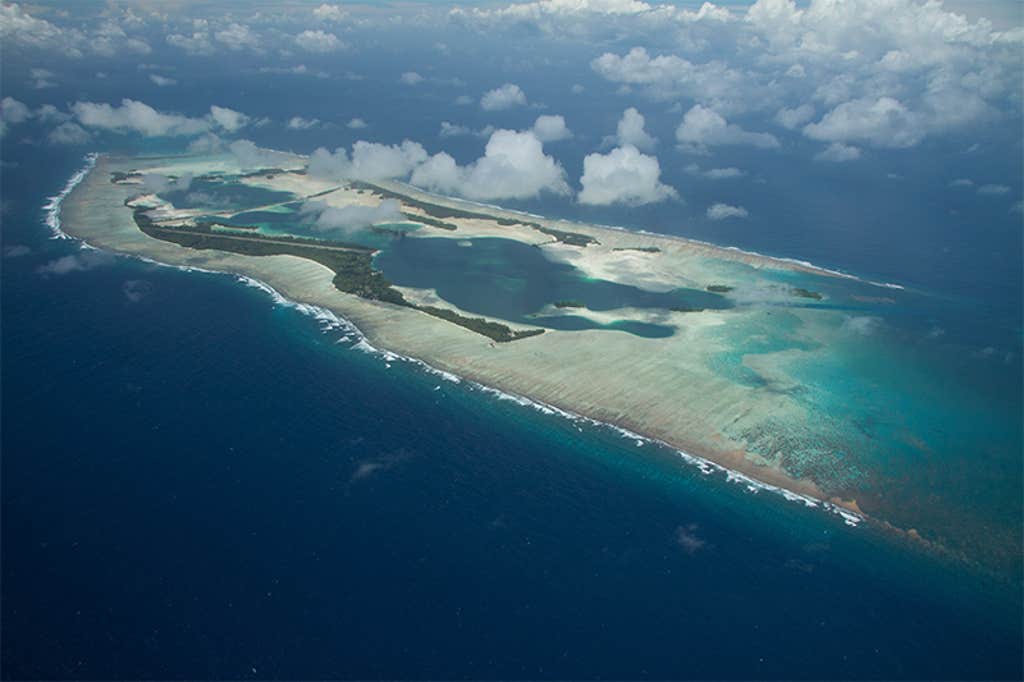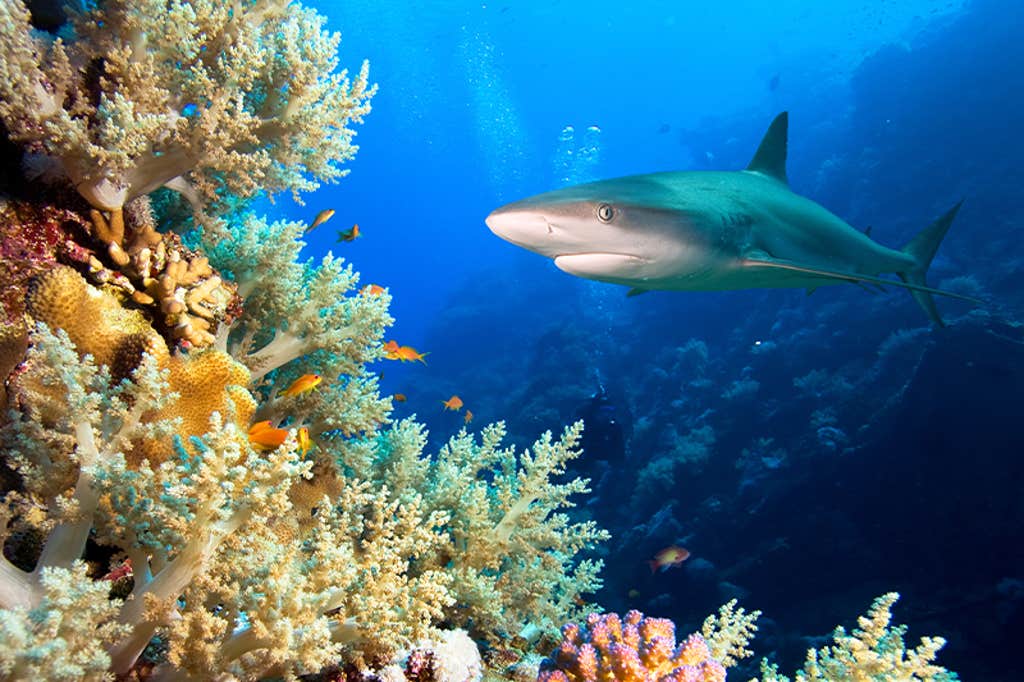When I think about what “wild” or “pristine” means, I immediately go underwater in my head. I am a marine community ecologist. As such, I am interested in how underwater ecosystems are structured and how they change through time.
In building a vision of “wild,” we each can pull from multiple sources. We can turn to history, our oral, and, more recently, our written history that describes what underwater ecosystems looked like to our ancestors and how the human relationship with the ecosystem used to appear. We turn to personal experiences, in this case to experiences that we have had exploring underwater ecosystems. If I close my eyes and imagine “wild,” I see a scene that is vivid and visceral, with big animals, maybe a lot of sharks, and a seafloor that is calcifying, growing, and creating the corals and calcified algae that construct tropical islands over millennia. What I see is a thriving coral reef.
My binary view of “people bad, no people good,” was kind of blown up a little bit.
About 20 years ago, we sought to describe with data what is “wild,” or what is “pristine” underwater. We did an expedition to what are amongst the most remote islands of the planet in the central, equatorial Pacific: the Line Island Archipelago. They’re a collection of islands that are managed by the Republic of Kiribati and by the United States. And in these islands there are some locations, some coral reefs, that have never experienced human habitation. We took a ship, maybe not the most beautiful of ships, but we did bring a team of world class scientists there to document what we could learn underwater.
We wanted to see what was swimming around. How many fish were there? What did they look like? How big? What species? We sought to find what the biodiversity was like, the number of species and where they lived. We looked at the bottom of the ocean to see how many corals were there, how much algae was there, and what else was competing for space. We looked at the water to think about how healthy it was, estimating how many bacteria, viruses, and nutrients were in the water. And all of this great work was summarized into a set of photographs, which to me emphasizes the importance of storytelling, of imagery and of art, even in the science that we do.
We were there to identify what a baseline coral reef could look like. We can recognize a healthy reef by looking for big fish and big corals. But when people are in the equation, we often see fewer big fish and we see less coral. Now, to me, this set a standard, which was that human habitation led to a decline and we could only find “wild” in the absence of people. While the basic narrative worked, there was something nagging me, maybe a fish nipping at my ear. The underwater world was telling me something different, that this binary view of resource management wasn’t quite correct and that the absence of people wasn’t the only way we would see “wild.”
The northern islands in the chain are the two uninhabited islands, Kingman and Palmyra. And there are also two islands farther south that have small populations of the islands’ indigenous people, the I-Kiribati, who are living off subsistence fishing and growing copra to make coconut oil.

More recently, we have continued our efforts to search for “wild” with a campaign called the 100 Island Challenge, which began in Micronesia working alongside some partners from the Micronesia Challenge. We went to the island of Pohnpei and then went offshore to the neighboring large atoll, Ant Atoll. And on Ant Atoll, we swam underwater, and we took a bunch of images to create landscape views of the coral reef. What we saw was an intact, what I would call a wild, coral reef. When we looked at the fish, the fish were big, and we saw predators all over the place. But this reef was one that was used, and is used, by Micronesians, by Pohnpeians, and has been for generations.
My binary view of “people bad, no people good,” was kind of blown up a little bit. And the story came down to something as straightforward as this: with engagement and stewardship from a community that cares about the natural resource, it is possible to manage that resource for today and for tomorrow. The traditional leaders of Ant and a lot of Pohnpei had taken proactive efforts to sustain and manage the natural resources underwater, and that management went from land to sea.
This experience got me really thinking about the human relationship with underwater resources. We’re, by and large, a terrestrial species. We live on land most of the time, and I started to think more about the human legacy of our relationship with the ocean. The human relationship has traditionally been one of land to sea management.
For example, the Hawaiian ahupua’a model takes a holistic, progressive approach to environmental management that sees the sea and land as connected. And it’s not just in the Hawaiian islands. In Tahiti, we talk about rāhui, which are protected areas for conservation and preservation of resources. And in Fiji and the Solomon Islands, there are analogous patterns of land to sea management. Think about the actions taken upslope influencing what happens downslope. And these systems aren’t as simple or linear as “don’t farm too much near a river, otherwise, soil will come into the river.” They are dynamic and responsive. When the Hawaiian population reached a maximum around 1400 A.D., at about a quarter-million people, there was some decimation happening to the natural marine resources. The population responded and updated some of their harvesting schemes and their food production schemes. And we can see in the archaeological evidence that the marine environment got healthier again. It was dynamic “ridge to reef” management—a holistic form of environmental stewardship that takes the land and the sea together.
I started to think more about the human legacy of our relationship with the ocean.
Invasive species have a huge impact on terrestrial ecosystems—but they also affect ocean ones. This is not news to anyone who knows islands to think that the foraging and burrowing of invasive pigs, the predatory activities of invasive rodents, or the grazing activities of invasive ungulates could have a dramatic impact on the terrestrial ecosystem. And those have knock-on implications, from vegetation to the animals, including important connector species like seabirds, sea turtles, and some of our marine pinnipeds.
Our current scientific endeavor has been finding a lot of great evidence that these changes on land are propagating in the sea. There’s a big benefit to having seabirds—that brings more nutrients into the ocean. There’s a big influence of watershed management—preventing soil from just filling the ocean ecosystem and sedimenting what is living nearby. And even diseases can be propagated from cats to seals in a really dramatic form of epidemiology that transcends both land and sea. There’s a lot that we know is happening that connects the land and the sea and we’re in the midst of a really exciting scientific period as we try to think about how those connections scale up from individual dynamics to entire community transitions.
I think about island restoration visually. Imagine an island that’s been denuded because of invasive species. We have very little vegetation, very few seabirds, and our watersheds are filled with dirt. And when it rains, the deluge fills the nearshore environment, with, in this case, red sediments that could bury reefs. Imagine that we dive underwater, and let’s see what its coral reef looks like. In this case, at this point in time, we may see that there’s very few corals, we may see that there’s algae in the place of where you would have calcifiers—the things that are building the island itself. And in this case, we may not see what we envision as “wild.”
But now, let’s fast forward. We can imagine what this island can look like as we transition over to a more intact ecosystem. What do we care about underwater? We care about these wild characteristics, we care about there being more coral growing there, we care about there being habitat for the food that we care about—the fishes. And we also care about resilience: The resilience in the face of climate change.

We’re talking today about the local impacts that people can have. Let’s recall that there is this existential threat that we have of climate change. We can’t fight it alone. And we have to consider the connections between land and sea. Imagine our restored reef again and now, pop your head out of the water. The once-bare island looks like we expect it to look; the vegetation has grown back and the watershed is functioning the way it did in its wild state. And there are a lot more of the seabirds and other animals that are the connector species between the land and the sea.
Yet I want to remind us all that the story is not so simple. We can’t guarantee that every island will see the same change if we eradicate invasive species. Natural history is an art form. Understanding the variability of coral reefs, or any natural ecosystems, is an art form. They’re all different; they all have a story to tell. And that’s why we need different communities to come together, in different environments and across different islands to work with scientific communities and other stakeholders to make a new community committed to island stewardship. We need to recognize that each of these islands and reefs has its own story, and needs its own level of support and caring to restore it to a wild state.
So let’s look underwater. Let’s share our experiences together and use technology much in the same way we use satellites or drone imagery to see the land, to see underwater and experience it together. Fishermen say they know what the fish are telling them. But the reef doesn’t have a voice. Technology that helps us see the reef and know its history gives it a voice to tell its story. We have to have that voice, we have to let that fish nip us in the ear and make us think about things. We need to hear the story together. ![]()
Lead image: Sarah_lewis / Shutterstock






















